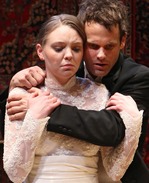SITE GUIDE
SEARCH
REVIEWS
REVIEW ARCHIVES
ADVERTISING AT CURTAINUP
FEATURES
NEWS
Etcetera and
Short Term Listings
LISTINGS
Broadway
Off-Broadway
NYC Restaurants
BOOKS and CDs
OTHER PLACES
Berkshires
London
California
New Jersey
DC
Connecticut
Philadelphia
Elsewhere
QUOTES
TKTS
PLAYWRIGHTS' ALBUMS
LETTERS TO EDITOR
FILM
LINKS
MISCELLANEOUS
Free Updates
Masthead
A CurtainUp Review
Double Falsehood
|
>We know there was a play called Cardenio written by Shakespeare and Fletcher and performed in the theatrical season of 1612-1613. We know that because there are two entries in the king's treasurer's payments made to the actors who performed in the play.— Brean Hammond, Editor, The Arden Shakespeare.
|

Clayton Apgar, MacKenzie Meehan
(Photo: Joan Marcus) |
Double Falsehood centers on an irresponsible and irascible young aristocrat, Henriquez (Slate Holmgren), who wrecks havoc on the lives of young maidens and their families with his unbridled libido. He becomes infatuated with a young maid of lower birth, Leonora (Hayley Treider), whose father, Don Bernardo (Jon DeVries), is so eager to marry into nobility that he willfully overlooks Henriquez's many flaws and the fact that his daughter is really in love with the dedicated and loyal Julio (Clayton Apgar).
For the most part, Director Brian Kulick sticks faithfully to the script. He gives lovers Julio and Leonora a bit more amorous license than the script appears to call for, but that's a minor quibble. The acting is strong. Mr. DeVries is robust, commanding and comedic as Leonora's father, Don Bernardo. Mr. Holmgren is the production's standout as Henriquez, balancing his character's sinister, naïve, bumbling, and insincere aspects to terrific effect. Ms. Treider as Lenora is particularly expressive with her body language and somehow illustrates her lines physically. And MacKenzie Meehan as the ravaged Violante transforms herself admirably from a young maid to a shepherd boy, living in disguised and humiliated exile in the countryside.
Oana Botez-Ban, working double duty as both scenic and costume designer, makes some odd but bold choices. Actors wear tuxedos, suits, and military garb from I don't know when. Her set design is uncomplicated: an array of Persian rugs hangs from the back wall of the stage, indicating simple, understated regalness. The strategy keeps the set bare bones and probably within budget; there are no additional props, despite the play's various settings: a royal palace, a village, and a pasture are just some of them. And, at times, Brian Scott's imaginative lighting makes the rugs appear almost translucent.
Less effective, however, is Director Kulick's group of scene changers, actors in trench coats and fedoras who drag three similar rugs around on the floor and organize them variously. The rugs are rather large and unwieldy, and no matter how gracefully the men drag them, the result is occasional first act distraction.
Even casual consumers of Shakespearean theater will find Double Falsehood's language rougher, less eloquent and perhaps even less clever than what they might ordinarily expect of the Bard. (It is believed that the play's final version retained more of Fletcher's lines in an attempt to make Shakespeare more accessible to Restoration audiences). All in all, though, Double Falsehood is a sturdy production. Contemporary audiences might be perplexed by the ending, but Double Falsehood is ultimately a play about grief, trauma, heartbreak, and family reconciliation.
But is it really "Shakespeare?" We may never know for certain. Scholars believe that he had more than a minor hand in its creation. Why not judge for yourself? You'll be one of those lucky few to have seen a professional production of this play in many generations.
|
Double falsehood By William Shakespeare and John Fletcher, adapted by Lewis Theobald Directed by Brian Kulick Cast: Bryce Gill (Roderick/Citizen/Shepherd), Philip Goodwin (Duke/Camillo/Shepherd), Clayton Apgar (Julio), Hayley Treider (Leonora), Jon DeVries (Don Bernardo), Slate Holmgren (Henriquez), MacKenzie Meehan (Violante) Set Design: Oana Botez-Ban Costume Design: Oana Botez-Ban Lighting Design: Brian H. Scott Sound Design and Original Music: Christian Frederickson Stage Manager: Andrea Wales Running Time: 1 hour, 50 minutes (with one ten minute intermission) Classic Stage Company, 136 E. 13th Street, www.classicstage.org From 3/12/11; opening 3/22/11; closing 4/3/11 Performance schedule Tues. - Sat. @ 8pm, Sunday @ 2pm (matinee) Reviewed by William Coyle, based on 3/18/11 performance |
|
REVIEW FEEDBACK Highlight one of the responses below and click "copy" or"CTRL+C"
Paste the highlighted text into the subject line (CTRL+ V): Feel free to add detailed comments in the body of the email. . .also the names and emails of any friends to whom you'd like us to forward a copy of this review. Visit Curtainup's Blog Annex For a feed to reviews and features as they are posted add http://curtainupnewlinks.blogspot.com to your reader Curtainup at Facebook . . . Curtainup at Twitter Subscribe to our FREE email updates: E-mail: esommer@curtainup.comesommer@curtainup.com put SUBSCRIBE CURTAINUP EMAIL UPDATE in the subject line and your full name and email address in the body of the message. If you can spare a minute, tell us how you came to CurtainUp and from what part of the country. |

Slings & Arrows-the complete set
You don't have to be a Shakespeare aficionado to love all 21 episodes of this hilarious and moving Canadian TV series about a fictional Shakespeare Company






